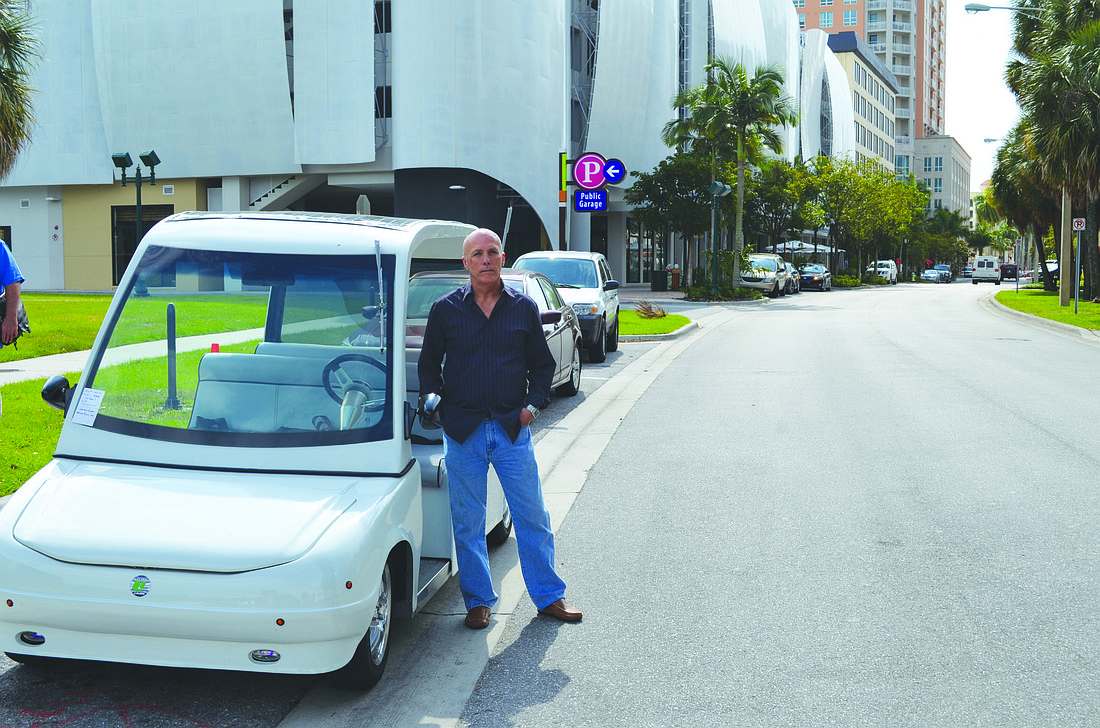- April 24, 2024
-
-
Loading

Loading

On the morning of April 17, John Moran rode in a circle around downtown for nearly two hours, a ritual he had participated in or kept a watchful eye on two other times in the preceding three months.
After he was done with the ride — a test drive, of sorts — Moran still had no way of knowing if the six-seat electric vehicle was what he needed. Still, he was optimistic he might be one step closer to establishing a circulator route to transport people throughout Sarasota’s downtown.
Moran, the operating manager of the city’s Downtown Improvement District, is one of the leading advocates for a downtown circulator transit system. His first goal is to find a vehicle that can last the course of a proposed 12-hour workday without needing to be recharged. That’s necessary for the type of hyper-efficient system Moran has envisioned: one that picks up passengers every five minutes along Main Street, Palm Avenue and at adjacent hotels.
One reason a downtown circulator is necessary, Moran says, is because of the quantity of large pedestrian generators near the bayfront. These attractions, such as Marina Jack or the Ritz-Carlton, Sarasota, are just far enough that some residents and visitors are reluctant to walk from them to the downtown core.
To eliminate that reluctance, he believes the city has to not only provide a transit option to pedestrians, but also make that transit option extremely convenient. Under Moran’s proposed circulator system, all the passengers would have to do is find a stop and wait no more than five minutes.
“They know they can conveniently get throughout downtown without any thinking, without planning, without any parking uncertainty,” Moran said. “That’s what the benefit of such a system is.”
By reducing barriers to the downtown area and encouraging increased movement, Moran believes businesses will see an uptick in traffic.
“We will expose people to parts of the city, views of the city that they may not have been exposed to before,” Moran said. “This can be an economic development generator for downtown.”
Moran points to figures from the city that estimate current planned downtown hotels will, in total, be able to generate an additional 100,000 visitors annually. He believes that, if those visitors can get around the city with ease, downtown businesses stand to benefit greatly.
Although the proposed route is specifically designed to target downtown hotels, Visit Sarasota County Managing Director Stephanie Grosskreutz questioned whether the existing hotels would be interested in covering the costs of a downtown circulator.
“The Hyatt and the Ritz already shuttle their guests back and forth,” Grosskreutz said. “They’d certainly be thrilled to participate in this if something came back on board, but not necessarily interested in contributing financially.”
Leslie Power, general manager of Hotel Indigo, said she did feel there was a demand for a circulator vehicle. She envisioned a more ambitious route than the one Moran outlined, one traveling to landmarks such as Mote Marine or the Ringling Museum. Although her vision differed from the most prominent current proposal, she encouraged Moran to move forward with his efforts.
“I think we have to start somewhere, and, ideally, we do get a circulator in place,” Power said. “If it’s just the downtown area, hopefully there’s potential to grow it out to St. Armands, Lido Beach, Siesta Beach, and we look at ways to alleviate traffic congestion.”
Chris Levine, Hyatt Regency Sarasota’s director of sales and marketing, said the circulator wasn’t essential to the hotel, since it has its own shuttles. Still, he said, it would be nice to have the option to offer customers more frequent service, particularly during the height of season.
Grosskreutz agreed with Moran about the potential economic power of the downtown circulator, though she believed the benefit may come from a different place. Grosskreutz thinks the circulator would be an attractive option for people wanting to shop without having to deal with the hassles of finding a space or moving their cars after two hours. By stopping at downtown parking garages, she said the circulator would allow people to leave their car behind and still move about downtown.
“I think the demand is more on the retailer’s side,” Grosskreutz said. “The desire is, once people park in one of the garages, is there an easy way to get to upper Main or down on Palm?”
Last Thursday’s test drive of a Lectric Limo electric car was cut short due to rain, but Moran said the vehicle had an extrapolated range of 83 miles — more than enough to cover the 12-hour route. After Moran believes he’s found the correct vehicle, his next challenge will be financing the project.
Currently, Moran is planning to divide the expenditures into two areas. The first would be the fixed costs: leasing, insuring and maintaining the vehicles. Moran estimates those costs would be around $115,000 annually, and that a city entity such as the Downtown Improvement District would be able to cover that expense.
Moran said a private entity would manage and pay for the operations of the circulator. He’s hoping to find an entrepreneur willing to take on the challenge. He said an interested party could sell advertising space and rent out the vehicles in exchange for hiring and training drivers.
However it gets done, Moran thinks downtown stakeholders should be determined to get a circulator in place — if not for the added convenience, then for the potential financial benefits.
“For the downtown business community, this is an economic development opportunity,” Moran said.
Contact David Conway at [email protected]